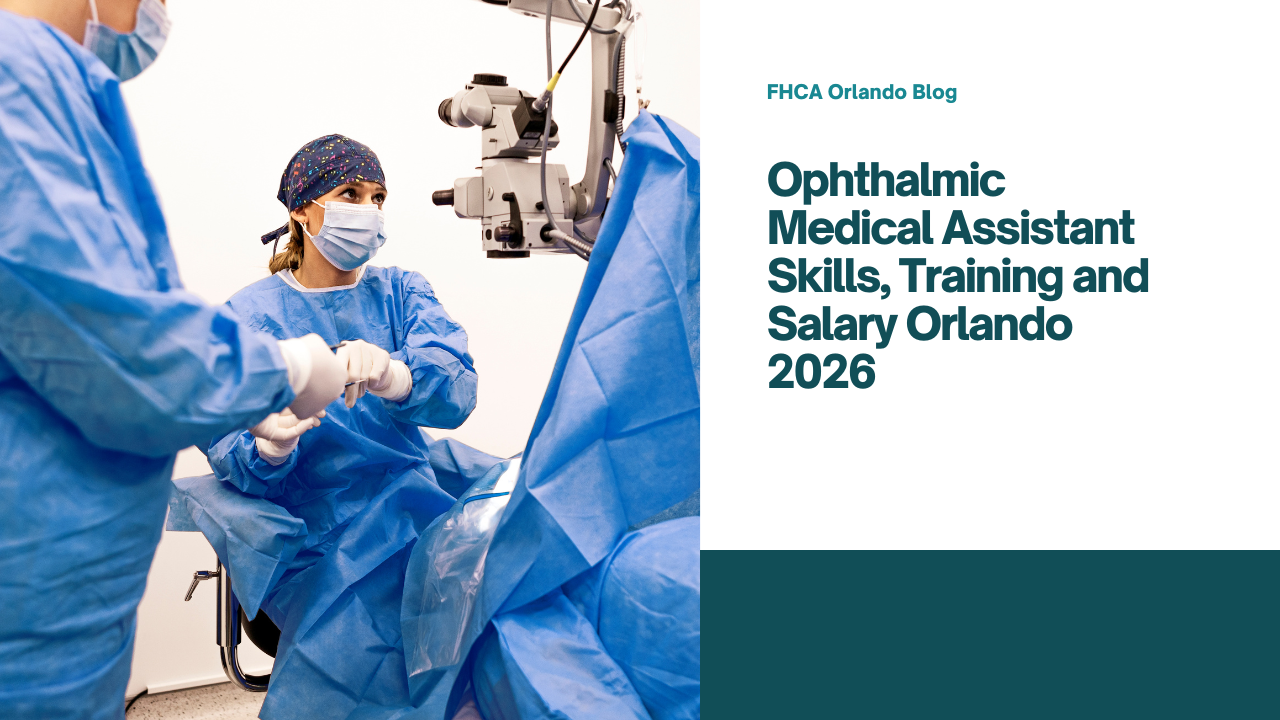Ophthalmic Medical Assistant Skills, Training and Salary Orlando 2026
Nov 26, 2025
Florida Health Care Academy Orlando prepares you for specialized roles in healthcare, including one of the most focused clinical paths: becoming an ophthalmic medical assistant. If you’re detail-oriented and interested in eye care, this role blends patient interaction with technical procedures in a fast-paced setting.
You’ll build on a foundation like the one offered in the medical assistant program Orlando, then specialize in supporting ophthalmologists in both clinical and administrative tasks.
Table of content
- What does an ophthalmic medical assistant do?
- Key skills for an ophthalmic medical assistant
- Education and training requirements to become an ophthalmic medical assistant
- Salary and job outlook for ophthalmic medical assistants
- How to transition from a general medical assistant to an ophthalmic medical assistant
- Why choose FHCA Orlando for your ophthalmic medical assistant training
- Ophthalmic medical assistant FAQs
What does an ophthalmic medical assistant do?
Ophthalmic medical assistants support eye care specialists in clinics, surgical centers, and ophthalmology practices. Your role combines direct patient care with administrative coordination.
Patient-care responsibilities
You may conduct vision tests, measure eye pressure, prepare patients for procedures, and assist with diagnostic imaging. These hands-on tasks make you a critical part of the patient journey in eye care.
Administrative tasks in the eye-care setting
Ophthalmic assistants also manage appointment scheduling, patient charts, billing, and referrals. Strong organizational skills ensure smooth operations in busy ophthalmology practices.
Key skills for an ophthalmic medical assistant
Success in this role depends on both technical abilities and interpersonal strengths. You’ll need to balance precision with compassion every day.
Communication and patient interaction
You must clearly explain procedures and put patients at ease, especially those with anxiety or visual impairments. Empathy and active listening are essential.
Organizational ability and tech proficiency
Using diagnostic software, updating charts, and handling optical tools all require attention to detail. These skills align closely with the medical assistant qualities valued across healthcare roles.
Education and training requirements to become an ophthalmic medical assistant
While some skills overlap with general medical assisting, this specialty often requires additional training in ophthalmology-specific procedures and tools.
Formal program or certificate options
You can pursue a certificate in ophthalmic assisting or complete an accredited medical assistant program that offers a concentration in eye care. FHCA Orlando provides the foundation you need to begin this path.
On-the-job training and specialization
Many ophthalmology clinics offer on-site training for entry-level medical assistants. This experience can lead to specialization and advancement. Understanding the medical assistant job description helps clarify where your responsibilities evolve in this field.
Salary and job outlook for ophthalmic medical assistants
The average salary for ophthalmic medical assistants in Florida ranges from $35,000 to $45,000, depending on experience, certification, and work setting.
Specialized roles like this one are often listed among the highest paid medical assistant specialties, especially for those with certification from the Joint Commission on Allied Health Personnel in Ophthalmology (JCAHPO).
How to transition from a general medical assistant to an ophthalmic medical assistant
If you already have medical assistant experience, you can pivot into ophthalmology through targeted training, hands-on practice, and professional connections.
Build relevant experience
Start by working in clinics that offer eye-related services. Support procedures like vision tests, patient prep, and basic screenings to develop practical knowledge.
Additional training and certification
Pursue continuing education or specialized certificates in ophthalmology. Some employers sponsor this training once you’re hired.
Networking and applying for specialist roles
Connect with professionals in the field through job shadowing or local associations. Update your resume to highlight transferable skills, especially those listed in medical assistant daily tasks.
Why choose FHCA Orlando for your ophthalmic medical assistant training
Florida Health Care Academy offers hands-on instruction, exam prep, and job support to help you thrive in specialized healthcare roles. Whether you’re starting your journey or looking to specialize, FHCA’s training equips you with the confidence and skills employers expect.
With a solid clinical foundation, you can move into eye care settings and build toward a career that’s focused, rewarding, and in demand.
Ophthalmic medical assistant FAQs
What’s the role of an ophthalmic medical assistant?
You’ll assist ophthalmologists with eye exams, prepare patients for procedures, and manage clinical and front-office duties.
Do I need formal education to become an ophthalmic medical assistant?
While not always required, formal training increases your job opportunities and readiness for certification.
What key skills do I need for this role?
Communication, attention to detail, and comfort with clinical tools are essential.
How can FHCA Orlando help me become an ophthalmic medical assistant?
FHCA provides practical training and support that helps you enter the field confidently and professionally.
What are the job prospects for ophthalmic medical assistants?
Demand is growing due to an aging population and increased need for eye care services across Florida.
Get started with ophthalmic medical assistant training at FHCA Orlando
If you’re ready to specialize in eye care and grow in your clinical career, Florida Health Care Academy gives you the tools to succeed. With real practice and expert instruction, you’ll be equipped to support ophthalmologists and stand out in the healthcare field.
Visit our Enrollment page and explore the medical assistant program Orlando to begin your path toward becoming an ophthalmic medical assistant.









